牛津译林版(2019)必修 第二册Unit 3 Festivals and customs课件(共11张PPT)
文档属性
| 名称 | 牛津译林版(2019)必修 第二册Unit 3 Festivals and customs课件(共11张PPT) | 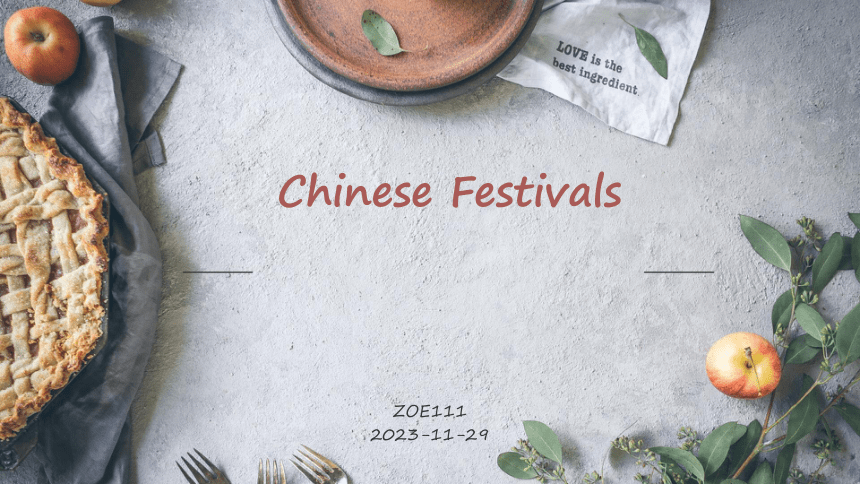 | |
| 格式 | pptx | ||
| 文件大小 | 1.7MB | ||
| 资源类型 | 教案 | ||
| 版本资源 | 牛津译林版(2019) | ||
| 科目 | 英语 | ||
| 更新时间 | 2023-11-29 11:18:44 | ||
图片预览

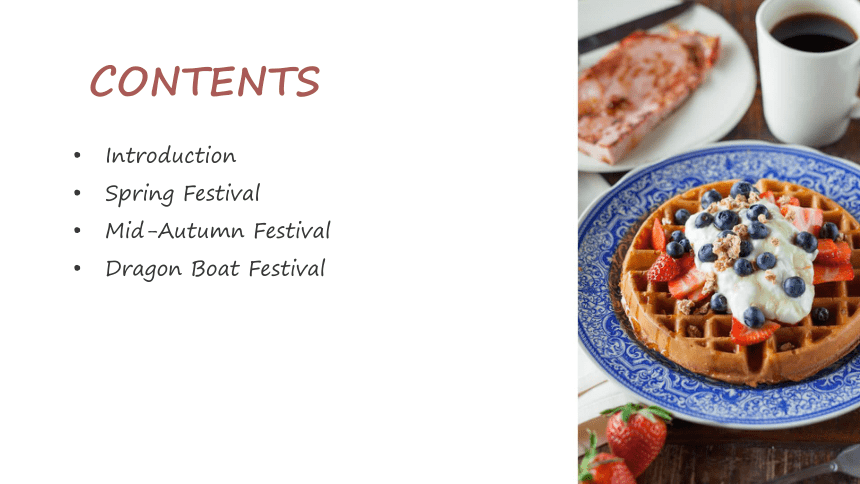
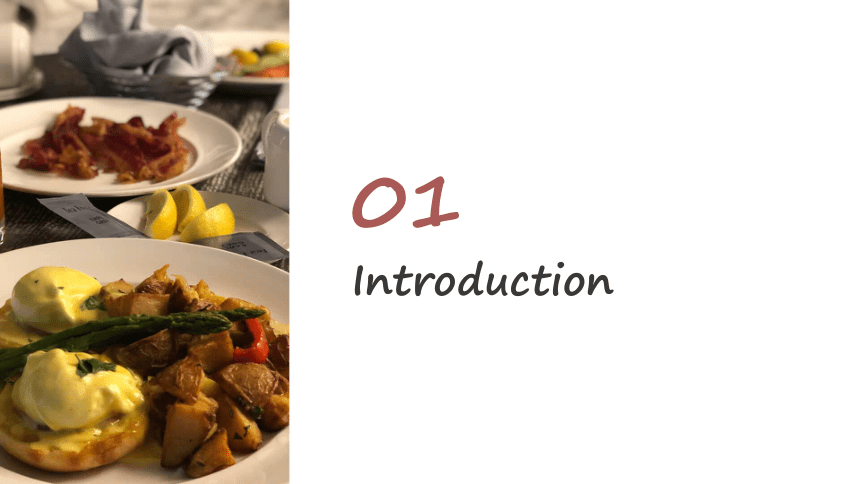
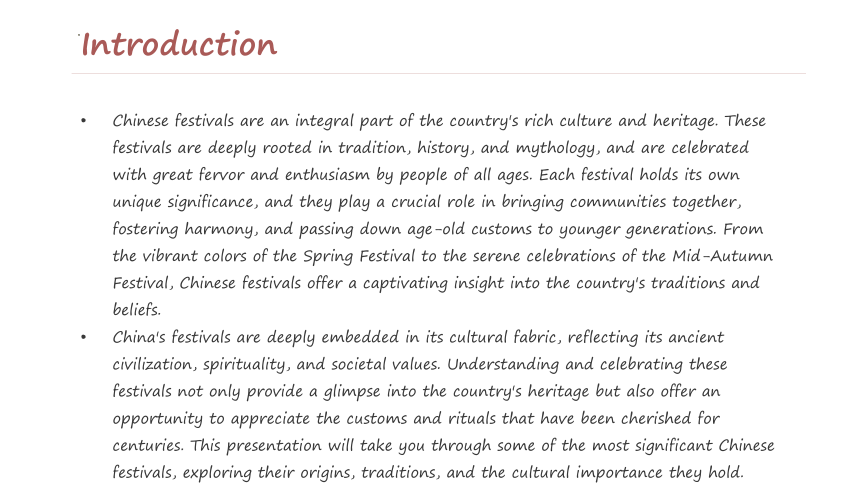
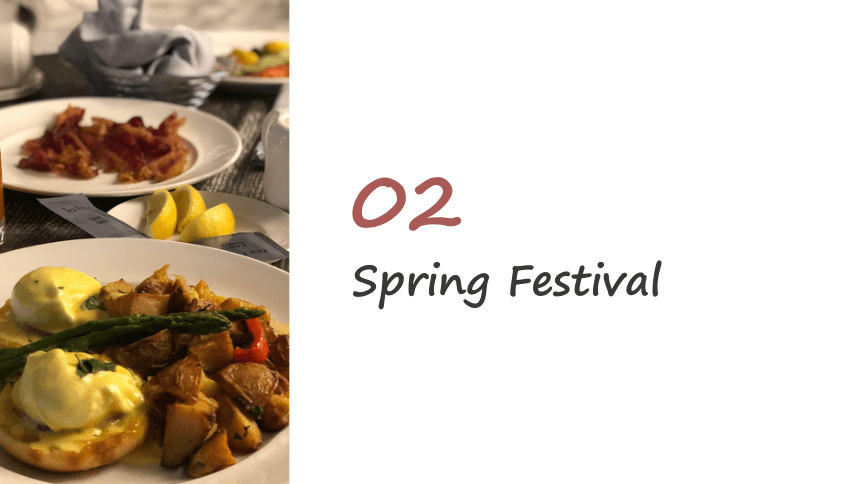
文档简介
(共11张PPT)
Chinese Festivals
ZOE111
2023-11-29
CONTENTS
Introduction
Spring Festival
Mid-Autumn Festival
Dragon Boat Festival
01
Introduction
Introduction
Chinese festivals are an integral part of the country's rich culture and heritage. These festivals are deeply rooted in tradition, history, and mythology, and are celebrated with great fervor and enthusiasm by people of all ages. Each festival holds its own unique significance, and they play a crucial role in bringing communities together, fostering harmony, and passing down age-old customs to younger generations. From the vibrant colors of the Spring Festival to the serene celebrations of the Mid-Autumn Festival, Chinese festivals offer a captivating insight into the country's traditions and beliefs.
China's festivals are deeply embedded in its cultural fabric, reflecting its ancient civilization, spirituality, and societal values. Understanding and celebrating these festivals not only provide a glimpse into the country's heritage but also offer an opportunity to appreciate the customs and rituals that have been cherished for centuries. This presentation will take you through some of the most significant Chinese festivals, exploring their origins, traditions, and the cultural importance they hold.
02
Spring Festival
Spring Festival
The Spring Festival, also known as Chinese New Year, is the most significant and widely celebrated festival in China. It marks the beginning of the lunar new year and is a time for family reunions, joyful gatherings, and age-old customs. The festival's origins can be traced back thousands of years to ancient agrarian societies, where it was celebrated to pray for a good harvest and blessings from the gods.
During the Spring Festival, streets are adorned with vibrant red decorations, traditional lion and dragon dances are performed, and the air is filled with the sound of firecrackers. Families come together for a lavish reunion dinner, featuring auspicious dishes such as fish, dumplings, and longevity noodles. The festival culminates in the spectacular Lantern Festival, where intricate lanterns are displayed, symbolizing hopes for a bright future.
03
Mid-Autumn Festival
Mid-Autumn Festival
The Mid-Autumn Festival, also known as the Moon Festival, is a time for reflection, appreciation, and togetherness. Celebrated on the 15th day of the 8th lunar month, it is a symbol of reunion and harmony. One of the most iconic traditions of this festival is the consumption of mooncakes, a delicacy made from sweet fillings and flaky pastry. These mooncakes are exchanged as gifts, symbolizing unity and good fortune.
The Mid-Autumn Festival is deeply rooted in Chinese folklore, particularly the legend of Chang'e, the mythical Moon Goddess. Families and friends come together to admire the full moon, share stories, and partake in traditional activities such as lantern-making and moon-gazing. It is a time of spiritual contemplation and expressing gratitude for the bounties of nature.
04
Dragon Boat Festival
Dragon Boat Festival
The Dragon Boat Festival, also known as Duanwu Festival, is a captivating celebration steeped in history and legend. Held on the 5th day of the 5th lunar month, it commemorates the life of the revered poet and statesman, Qu Yuan. One of the festival's highlights is the exhilarating dragon boat races, where intricately decorated boats race across waterways to the rhythmic drumbeats.
The festival is also known for the tradition of eating zongzi, pyramid-shaped glutinous rice dumplings wrapped in bamboo leaves. These savory treats are said to have been thrown into the river to prevent fish from consuming Qu Yuan's body after he tragically drowned himself. Through dragon boat races, zongzi feasts, and other customs, the Dragon Boat Festival pays homage to Qu Yuan's patriotism and provides a captivating window into China's historical and cultural legacy.
This presentation provides a glimpse into the essence of Chinese festivals, showcasing their intricate traditions and the profound cultural values they represent. Embracing these festivities offers a profound appreciation of China's rich heritage and the enduring customs that continue to unite communities and foster enduring connections.
THE END
THANKS
Chinese Festivals
ZOE111
2023-11-29
CONTENTS
Introduction
Spring Festival
Mid-Autumn Festival
Dragon Boat Festival
01
Introduction
Introduction
Chinese festivals are an integral part of the country's rich culture and heritage. These festivals are deeply rooted in tradition, history, and mythology, and are celebrated with great fervor and enthusiasm by people of all ages. Each festival holds its own unique significance, and they play a crucial role in bringing communities together, fostering harmony, and passing down age-old customs to younger generations. From the vibrant colors of the Spring Festival to the serene celebrations of the Mid-Autumn Festival, Chinese festivals offer a captivating insight into the country's traditions and beliefs.
China's festivals are deeply embedded in its cultural fabric, reflecting its ancient civilization, spirituality, and societal values. Understanding and celebrating these festivals not only provide a glimpse into the country's heritage but also offer an opportunity to appreciate the customs and rituals that have been cherished for centuries. This presentation will take you through some of the most significant Chinese festivals, exploring their origins, traditions, and the cultural importance they hold.
02
Spring Festival
Spring Festival
The Spring Festival, also known as Chinese New Year, is the most significant and widely celebrated festival in China. It marks the beginning of the lunar new year and is a time for family reunions, joyful gatherings, and age-old customs. The festival's origins can be traced back thousands of years to ancient agrarian societies, where it was celebrated to pray for a good harvest and blessings from the gods.
During the Spring Festival, streets are adorned with vibrant red decorations, traditional lion and dragon dances are performed, and the air is filled with the sound of firecrackers. Families come together for a lavish reunion dinner, featuring auspicious dishes such as fish, dumplings, and longevity noodles. The festival culminates in the spectacular Lantern Festival, where intricate lanterns are displayed, symbolizing hopes for a bright future.
03
Mid-Autumn Festival
Mid-Autumn Festival
The Mid-Autumn Festival, also known as the Moon Festival, is a time for reflection, appreciation, and togetherness. Celebrated on the 15th day of the 8th lunar month, it is a symbol of reunion and harmony. One of the most iconic traditions of this festival is the consumption of mooncakes, a delicacy made from sweet fillings and flaky pastry. These mooncakes are exchanged as gifts, symbolizing unity and good fortune.
The Mid-Autumn Festival is deeply rooted in Chinese folklore, particularly the legend of Chang'e, the mythical Moon Goddess. Families and friends come together to admire the full moon, share stories, and partake in traditional activities such as lantern-making and moon-gazing. It is a time of spiritual contemplation and expressing gratitude for the bounties of nature.
04
Dragon Boat Festival
Dragon Boat Festival
The Dragon Boat Festival, also known as Duanwu Festival, is a captivating celebration steeped in history and legend. Held on the 5th day of the 5th lunar month, it commemorates the life of the revered poet and statesman, Qu Yuan. One of the festival's highlights is the exhilarating dragon boat races, where intricately decorated boats race across waterways to the rhythmic drumbeats.
The festival is also known for the tradition of eating zongzi, pyramid-shaped glutinous rice dumplings wrapped in bamboo leaves. These savory treats are said to have been thrown into the river to prevent fish from consuming Qu Yuan's body after he tragically drowned himself. Through dragon boat races, zongzi feasts, and other customs, the Dragon Boat Festival pays homage to Qu Yuan's patriotism and provides a captivating window into China's historical and cultural legacy.
This presentation provides a glimpse into the essence of Chinese festivals, showcasing their intricate traditions and the profound cultural values they represent. Embracing these festivities offers a profound appreciation of China's rich heritage and the enduring customs that continue to unite communities and foster enduring connections.
THE END
THANKS
